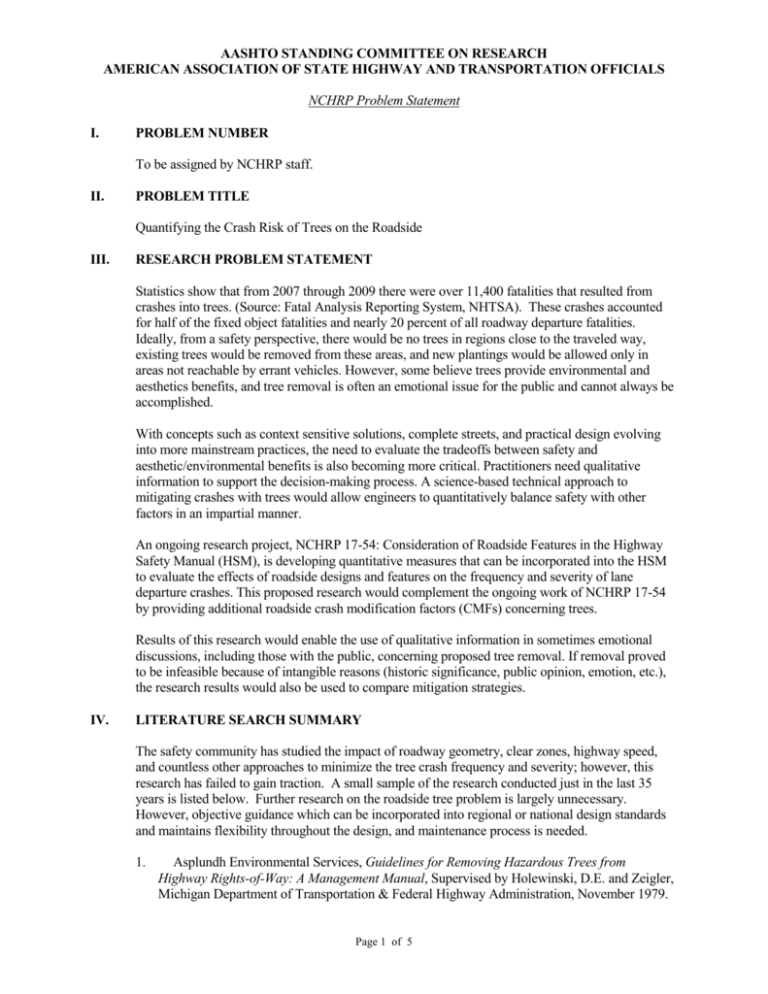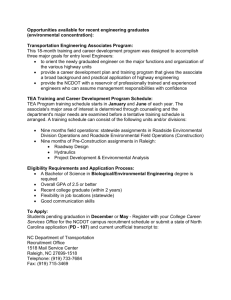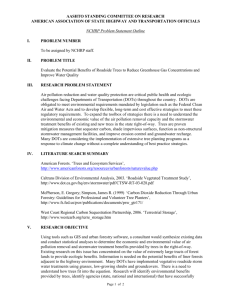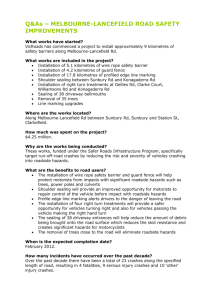NCHRP Problem Statement 1_Trees_8-13 final
advertisement

AASHTO STANDING COMMITTEE ON RESEARCH AMERICAN ASSOCIATION OF STATE HIGHWAY AND TRANSPORTATION OFFICIALS NCHRP Problem Statement I. PROBLEM NUMBER To be assigned by NCHRP staff. II. PROBLEM TITLE Quantifying the Crash Risk of Trees on the Roadside III. RESEARCH PROBLEM STATEMENT Statistics show that from 2007 through 2009 there were over 11,400 fatalities that resulted from crashes into trees. (Source: Fatal Analysis Reporting System, NHTSA). These crashes accounted for half of the fixed object fatalities and nearly 20 percent of all roadway departure fatalities. Ideally, from a safety perspective, there would be no trees in regions close to the traveled way, existing trees would be removed from these areas, and new plantings would be allowed only in areas not reachable by errant vehicles. However, some believe trees provide environmental and aesthetics benefits, and tree removal is often an emotional issue for the public and cannot always be accomplished. With concepts such as context sensitive solutions, complete streets, and practical design evolving into more mainstream practices, the need to evaluate the tradeoffs between safety and aesthetic/environmental benefits is also becoming more critical. Practitioners need qualitative information to support the decision-making process. A science-based technical approach to mitigating crashes with trees would allow engineers to quantitatively balance safety with other factors in an impartial manner. An ongoing research project, NCHRP 17-54: Consideration of Roadside Features in the Highway Safety Manual (HSM), is developing quantitative measures that can be incorporated into the HSM to evaluate the effects of roadside designs and features on the frequency and severity of lane departure crashes. This proposed research would complement the ongoing work of NCHRP 17-54 by providing additional roadside crash modification factors (CMFs) concerning trees. Results of this research would enable the use of qualitative information in sometimes emotional discussions, including those with the public, concerning proposed tree removal. If removal proved to be infeasible because of intangible reasons (historic significance, public opinion, emotion, etc.), the research results would also be used to compare mitigation strategies. IV. LITERATURE SEARCH SUMMARY The safety community has studied the impact of roadway geometry, clear zones, highway speed, and countless other approaches to minimize the tree crash frequency and severity; however, this research has failed to gain traction. A small sample of the research conducted just in the last 35 years is listed below. Further research on the roadside tree problem is largely unnecessary. However, objective guidance which can be incorporated into regional or national design standards and maintains flexibility throughout the design, and maintenance process is needed. 1. Asplundh Environmental Services, Guidelines for Removing Hazardous Trees from Highway Rights-of-Way: A Management Manual, Supervised by Holewinski, D.E. and Zeigler, Michigan Department of Transportation & Federal Highway Administration, November 1979. Page 1 of 5 2. Zeigler, A.J., Guide to Management of Roadside Trees, FHWA-IP-86-17, Michigan Department of Transportation, December 1986. 3. Zeigler, A.J., Risk of Vehicle-Tree Accidents and Management of Roadside Trees, Transportation Research Record No. 1127, Transportation Research Board, Washington, D.C., 1987. 4. Turner, D.S. and Mansfield, E.R., Urban Trees and Roadside Safety, Journal of Transportation Engineering, Vol. 116, No. 1, American Society of Civil Engineers (ASCE), January 1990. 5. Vegetation Control for Safety – A Guide for Street and Highway Maintenance Personnel, FHWA-RT-90-003, Project No. 70, By the Technology Transfer Center, Iowa State University, For the Federal Highway Administration, U.S. Department of Transportation, 1990. 6. Ray, M.H., Troxel, L.A., and Carney, J.F., III, Characteristics of Fixed-Roadside-Object Side-Impact Accidents, Journal of Transportation Engineering, Vol. 117, No. 3, American Society of Civil Engineers (ASCE), May/June 1991. 7. Viner, J., Harmful Events in Crashes, Accident Analysis and Prevention, Volume 25, No. 2, Pergamon Press Ltd., 1993. 8. Haworth, N., Vulcan, P., Bowland, L., and Pronk, N., Fatal Single Vehicle Crashes Study – Summary Report, Report No. 122, Monash University, Victoria, Australia, September 1997. 9. Kloeden, C.N., McLean, A.J., Baldock, M.R.J., and Cockington, A.J.T., Severe and Fatal Car Crashes Due to Roadside Hazards, By NHMRC Road Accident Research Unit, University of Adelaide, South Australia, For Motor Accident Commission, May 1999. 10. Johnson, A.M., Best Practices Handbook on Roadside Vegetation Management, Report No. MN/DOT 2000-19, By Professional Engineering Services, Ltd., For University of Minnesota, Center for Transportation Studies, Minneapolis, Minnesota, September 2000. 11. Haworth, N. and Bowland, L., Serious Injury Single Vehicle Crashes, Report No. 175, Monash University, Accident Research Centre, Victoria, Australia, December 2000. 12. McGinnis, R.G., Strategic Plan for Improving Roadside Safety, NCHRP Web Document 33, Project G17-13, Contractor’s Final Report, National Cooperative Highway Research Program (NCHRP), Washington, D.C., February 2001. 13. Sullivan, E., Jud, E., Ringstmeyer, D., and Finnecy, B., Safety of Trees with Narrow Clear Zones on Urban Highways, Phase I Report (Draft v.2), By Cal Poly State University, For State of California, Department of Transportation, January 2002. 14. Sullivan, E., Safety of Median Trees with Narrow Clearances on Urban Conventional Highways, Phase II Final Report, By Cal Poly State University, For State of California, Department of Transportation, February 2003. 15. Sullivan, E., Safety of Median Trees with Narrow Clearances on Urban Conventional Highways, Phase III Final Report, By Cal Poly State University, For State of California, Department of Transportation, March 2004. 16. Neuman, T.R., Pfefer, R., Slack, K.L., Lacy, K., Zegeer, C., Guidance for Implementation of AASHTO Strategic Highway Safety Plan – Volume 3: A Guide for Addressing Collisions with Trees in Hazardous Locations, National Cooperative Highway Research Program (NCHRP) Report No. 500, Transportation Research Board, Washington, D.C., 2003. Page 2 of 5 V. 17. Field Guide for Unpaved Rural Roads, For Federal Highway Administration – Local technical Assistance Program, By Wyoming Technology Transfer (T2) Center – March 1997 and Kansas Local Technical Assistance Program (LTAP) – July 2004. 18. Bratton, N.J. and Wolf, K.L., Trees and Roadside Safety in U.S. Urban Settings, Conference Proceedings of the 84th Annual Meeting of the Transportation Research Board, Transportation Research Board, Washington, D.C., 2005. 19. Mok, J.H., Landphair, H.C., and Naderi, J.R., Landscape Improvement Impacts on Roadside Safety in Texas, Landscape and Urban Planning, Number 78, 2006. 20. Martin, A.S., Milton, J., Hallenbeck, M.E., and Nee, J., In-Service Evaluation of Major Urban Arterials with Landscaped Medians – Conditions as of 2004, Report No. WA-RD 636.1, For Washington State Department of Transportation, By University of Washington, Washington State Transportation Center, Seattle, Washington, February 2007. 21. Mattox, T.B., Evaluation of Roadside Collisions with Utility Poles and Trees at Intersection Locations, Master’s Thesis, Georgia Institute of Technology, Georgia, December 2007. 22. Dixon, K.K., Liebler, M., Zhu, H., Hunter, M.P., and Mattox, B., Safe and Aesthetic Design of Urban Roadside Treatments, National Cooperative Highway Research Program (NCHRP) Report No. 612, Transportation Research Board, Washington, D.C., 2008. 23. Noyce, D.A., Martinez, C., and Chitturi, M., The Operational and Safety Impacts of Run-OffRoad Crashes in Wisconsin: Tree, Fence, and Pole Impacts, For Wisconsin Department of Transportation, By University of Wisconsin-Madison, Traffic Operations and Safety laboratory, Madison, Wisconsin, September 2008. 24. Briglia, P.M. Jr., Howard, Z.N., Fishkin, E., Hallenbeck, M.E., and Martin, A.S., In-Service Evaluation of Major Urban Arterials with Landscaped Medians – Phase II, Report No. WARD 636.2, For Washington State Department of Transportation, By University of Washington, Washington State Transportation Center, Seattle, Washington, July 2009. 25. Ogle, J., Sarasua, W., Dillon, J., Bendigieri, V., Anekar, S., and Alluri, P., Support for the Elimination of Roadside Hazards: Evaluating Roadside Collision Data and Clear Zone Requirements, Report No. FHWA-SC-09-01, For South Carolina Department of Transportation, By Clemson University, Clemson, South Carolina, September 2009. 26. Abidin, A.N.S.Z., Rahim, M.M.A., Voon, W.S., and Sohadi, R.U.R., Single-Vehicle Accidents Involving Trees in Malaysia – A Preliminary Study, Report No. MRR 12/2009, Malaysian Institute of Road Safety Research, Kuala Lumpur, 2009. 27. Pledge, A., Passive Safety Guidelines for Specification and Use of Passively Safe Street Furniture on the UK Road Network, Passive Safety UK, United Kingdom, April 2010. RESEARCH OBJECTIVE The objective of this research is to develop comprehensive objective guidance for use in design and maintenance of roadside trees so as to prevent or mitigate the impacts of crashes with trees. This guidance should maintain flexibility but balance motorist safety with environmental, aesthetic and emotional concerns. In order to achieve the research objective, the following tasks are anticipated: 1. Perform a criteria review of the published literature. 2. Conduct a survey of the states to collect existing policies. Page 3 of 5 3. Based on the results of the literature review and survey, suggest a series of alternatives to be evaluated using the third version of the Roadside Safety Analysis Program’s crash modification factor (CMF) development procedure developed and documented under the pending NCHRP 17-54. These alternatives should consider traffic volume, roadside slopes, tree offset, tree size, and tree density at a minimum. The effectiveness of placing barrier in front of trees or other countermeasures should be evaluated. 4. Identify crash data which can be used to develop Effective Fatal Crash Cost Ratios for use in the CMF development. Alternatives or hazards for which appropriate crash data are not available should be identified and methods to overcome the obstacles should be presented. 5. Submit a Phase I interim report, meet with the panel to review the findings of the report, and the suggested alternatives for consideration. It is the intent that the CMFs developed in Phase II of this research will be used with the Urban and Rural SPFs currently under development in NCHRP 17-54. 6. Execute Phase II to develop objective, flexible guidance. 7. Solicit feedback from other professional, organizations, or agencies. The concerns of the reviewers would be captured and, in conjunction with the panel, decisions made about modification to the guidelines. 8. Prepare a final report. VI. ESTIMATE OF PROBLEM FUNDING AND RESEARCH PERIOD Recommended Funding: $350,000 Research Period: 36 months VII. URGENCY, PAYOFF POTENTIAL, AND IMPLEMENTATION Trees are a source of contention on many projects and delay project development since current procedures do not often allow for a data-driven, quantifiable method for evaluating alternatives and balancing tradeoffs between safety and aesthetic or environmental concerns. This research will develop crash modification factors for elements related to placement of trees and countermeasures for preventing or mitigating crashes which will allow engineers to balance the competing factors. It is anticipated the results of this research will be used in conjunction with the SPFs developed under NCHRP 17-54. The findings from this research may necessitate revisions to AASHTO documents, most notably the Roadside Design Guide and the Highway Safety Manual. Some states may utilize this research as a foundation for policy development on evaluation of roadside landscaping treatments. VIII. PERSON(S) DEVELOPING THE PROBLEM Christine Carrigan, P.E., Ph.D. RoadSafe LLC 10 Main Street Canton, ME 04221 (207) 513-6057 445 ICTAS Building, Stanger Street (MC 0194) Blacksburg, VA 24061 (540) 231-7190 H. Clay Gabler, Ph.D. Professor, Biomedical Engineering Associate Department Head for Graduate Studies Virginia Tech - Wake Forest University School of Biomedical Engineering and Sciences Page 4 of 5 Ronald K. Faller, Ph.D., P.E. Midwest Roadside Safety Facility (MwRSF) Nebraska Transportation Center, University of Nebraska-Lincoln 130 Whittier Research Center 2200 Vine Street Lincoln, Nebraska 68583-0853 (402) 472-6864 IX. PROBLEM MONITOR AASHTO Technical Committee on Roadside Safety (TCRS) Member: Drew A. Boyce, P.E. Delaware Department of Transportation Assistant Director Project Development-North PO Box 778 800 Bay Road Dover, Delaware 19903 Phone: (302)760-2371 Fax: (302)739-2362 Email: drew.boyce@state.de.us X. DATE AND SUBMITTED BY August 16, 2013 Keith A. Cota, P.E. Chairman, Technical Committee on Roadside Safety New Hampshire DOT 7 Hazen Drive, PO Box 483 Concord, NH 03302-0483 Phone: 603-736-8811 Email: kcota@dot.state.nh.us. Page 2 of 5








